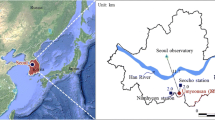Abstract.
By means of an onsite investigation, the largest debris flow in Taiwan's history is analyzed in this paper. A heavy rainfall of 1,748 mm/day occurred during typhoon Herb in the Hoser area at the end of July 1996. Aerial photographic assessment and observations of geological and geomorphological features have contributed to our understanding of this massive destruction. Mechanisms of the hazardous debris flow are explored and discussed. Data revealed that the rock discontinuities were a major factor in the voluminous loose materials in the debris flows. The heavy and rapid rainfall instantly transported massive amounts of debris flow materials into the center, and then quickly funneled them to the lower parts of gullies. The heavy slurry became an effective cutting device to erode the side walls and move large quantities of the debris materials to the end of the gullies.
Similar content being viewed by others
Author information
Authors and Affiliations
Additional information
Electronic Publication
Rights and permissions
About this article
Cite this article
Chen, H., Su, DY. Geological factors for hazardous debris flows in Hoser, central Taiwan. Env Geol 40, 1114–1124 (2001). https://doi.org/10.1007/s002540100312
Received:
Accepted:
Issue Date:
DOI: https://doi.org/10.1007/s002540100312




